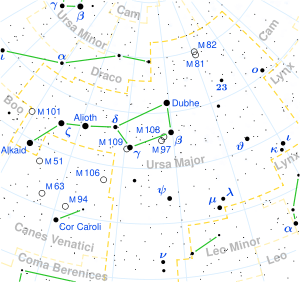Groombridge 1830
 Detailed position of HR 4550 ( = Groombridge 1830; bottom-left edge) related to Chi UMa and Psi UMa. | |
| Observation data Epoch J2000 Equinox J2000 | |
|---|---|
| Constellation | Ursa Major |
| Right ascension | 11h 52m 58.7691s[1] |
| Declination | +37° 43′ 07.239″[1] |
| Apparent magnitude (V) | 6.44[2] |
| Characteristics | |
| Spectral type | G8VIp[3] |
| U−B color index | +0.16[2] |
| B−V color index | +0.75[2] |
| Variable type | Suspected[4] |
| Astrometry | |
| Radial velocity (Rv) | –98.0[5] km/s |
| Proper motion (μ) | RA: 4,003.69[1] mas/yr Dec.: -5,813.00[1] mas/yr |
| Parallax (π) | 109.22 ± 0.78[1] mas |
| Distance | 29.9 ± 0.2 ly (9.16 ± 0.07 pc) |
| Absolute magnitude (MV) | 6.62 |
| Details | |
| Mass | 0.661[6] M☉ |
| Radius | 0.681 ± 0.006[7] R☉ |
| Luminosity | 0.212 ± 0.002[7] L☉ |
| Surface gravity (log g) | 4.68[8] cgs |
| Temperature | 4,759 ± 20[7] K |
| Metallicity [Fe/H] | –1.33[8] dex |
| Age | 4.7–5.3[9] Gyr |
| Other designations | |
| Database references | |
| SIMBAD | data |
Groombridge 1830 (1830 Groombridge, Argelander's Star)[10] is a star in the constellation Ursa Major.
Description
It is a yellow-hued class G8 subdwarf catalogued by Stephen Groombridge with the Groombridge Transit Circle between 1806 and the 1830s and published posthumously in his star catalog, Catalogue of Circumpolar Stars (1838). Its high proper motion was noted by Friedrich Wilhelm Argelander in 1842.
It is 29.9 light-years (9.2 parsecs) from the Sun as measured by the Hipparcos astrometry satellite,[1][11] which, as the distance is nearly 10 parsecs, means its absolute magnitude is almost equal to its apparent magnitude. It is a member of the galactic halo; such stars account for only 0.1 to 0.2 percent of the stars near the Sun. Like most halo stars, it has a low abundance of elements other than hydrogen and helium—what astronomers term a metal-poor star.[12]
Once suspected of being a binary star with a period of 175 days, current consensus is that it is single. Previous suspected observations of a stellar companion were probably "superflares"—analogous to the Sun's solar flares, but hundreds to millions of times more energetic.[12][13]
Proper motion
When discovered, it had the highest proper motion of any star known, replacing 61 Cygni in that department. Later it dropped to second place after the discovery of Kapteyn's Star, and still later to third place after the discovery of Barnard's Star. It is considerably farther away than either of those stars, however, which means its transverse velocity is greater.
Actually, it is the Sun which is following the motion of galaxy rotation by revolving around the center of the Milky Way; halo stars like Groombridge 1830 do not follow this galaxy rotation and thus are "standing still" and appear to be moving in "retrograde direction" at high speed.
References
- 1 2 3 4 5 6 Perryman, M. A. C.; et al. (1997). "The Hipparcos Catalogue". Astronomy & Astrophysics 323: L49–L52. Bibcode:1997A&A...323L..49P.
- 1 2 3 Argue, A. N. (1966). "UBV photometry of 550 F, G and K type stars". Monthly Notices of the Royal Astronomical Society 133: 475–493. Bibcode:1966MNRAS.133..475A. doi:10.1093/mnras/133.4.475.
- ↑ Johnson, H. L.; Morgan, W. W. (1953). "Fundamental stellar photometry for standards of spectral type on the revised system of the Yerkes spectral atlas". Astrophysical Journal 117: 313–352. Bibcode:1953ApJ...117..313J. doi:10.1086/145697.
- ↑ Kukarkin, B. V.; et al. (1981). Catalogue of suspected variable stars. Moscow, USSR: Academy of Sciences. Bibcode:1981NVS...C......0K.
- ↑ Evans, D. S. (June 20–24, 1966). "The Revision of the General Catalogue of Radial Velocities". In Batten, Alan Henry; Heard, John Frederick. Determination of Radial Velocities and their Applications, Proceedings from IAU Symposium no. 30. University of Toronto: International Astronomical Union. Retrieved 2009-09-10.
- ↑ Takeda, Genya; Ford, Eric B.; Sills, Alison; Rasio, Frederic A.; Fischer, Debra A.; Valenti, Jeff A. (February 2007). "Structure and Evolution of Nearby Stars with Planets. II. Physical Properties of ~1000 Cool Stars from the SPOCS Catalog". The Astrophysical Journal Supplement Series 168 (2): 297–318. arXiv:astro-ph/0607235. Bibcode:2007ApJS..168..297T. doi:10.1086/509763.
- 1 2 3 Boyajian, Tabetha S.; et al. (February 2012), "Stellar Diameters and Temperatures. I. Main-sequence A, F, and G Stars", The Astrophysical Journal 746 (1): 101, arXiv:1112.3316, Bibcode:2012ApJ...746..101B, doi:10.1088/0004-637X/746/1/101. See Table 10.
- 1 2 Soubiran, C.; Bienaymé, O.; Mishenina, T. V.; Kovtyukh, V. V. (March 2008). "Vertical distribution of Galactic disk stars. IV. AMR and AVR from clump giants". Astronomy and Astrophysics 480 (1): 91–101. arXiv:0712.1370. Bibcode:2008A&A...480...91S. doi:10.1051/0004-6361:20078788.
- ↑ Mamajek, Eric E.; Hillenbrand, Lynne A. (November 2008). "Improved Age Estimation for Solar-Type Dwarfs Using Activity-Rotation Diagnostics". The Astrophysical Journal 687 (2): 1264–1293. arXiv:0807.1686. Bibcode:2008ApJ...687.1264M. doi:10.1086/591785.
- ↑ Peters, C. A. F.; "On the Parallax of Argelander's Star", Monthly Notices of the Royal Astronomical Society, December 1853, v.50, p.302, Bibcode: 1853MNRAS..14...49P
- ↑ Perryman, Michael (2010), "The Making of History's Greatest Star Map", Astronomers’ Universe (Heidelberg: Springer-Verlag), Bibcode:2010mhgs.book.....P, doi:10.1007/978-3-642-11602-5
- 1 2 "Groombridge 1830". SolStation.
- ↑ Rubenstein, Eric P. (February 2001). "Superflares and Giant Planets". American Scientist 89 (1): 38. arXiv:astro-ph/0101573. Bibcode:2001AmSci..89...38R. doi:10.1511/2001.1.38.
External links
- Israelian, Garik; García López, Ramon J.; Rebolo, Rafael (1998). "Oxygen Abundances in Unevolved Metal-poor Stars from Near-Ultraviolet OH Lines". Astrophysical Journal 507 (2): 805–817. arXiv:astro-ph/9806235. Bibcode:1998ApJ...507..805I. doi:10.1086/306351.
- SolStation.com: Groombridge 1830
Discovery of high proper motion
- AN 19 (1842) 393/394 (in German)
- AN 20 (1843) 163/164 (in German)
- AN 20 (1843) 279/280
| ||||||||||||||||||||||||||||||||||||||||||||||||||||||||||||||||||||||||||||||||||||
| ||||||||||||||||||||||||||||||||||
